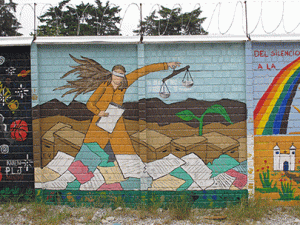Human Rights and Social Memory in Latin America RAP
Project 1, reported by Carlos Aguirre (Department of History) and Stephanie Wood (Research Associate, Center for Equity Promotion)

2016-17 Report: With initial encouragement from June Black at the Jordan Schnitzer Museum of Art (June is now at another art museum in Idaho) our RAP has been moving forward, nevertheless, researching the theme of human rights as expressed in art. Works of art can provide powerful imagery that contribute to social and cultural memory. For example, the textile appliqué work known widely as arpilleras and produced by women in Chile who were protesting the abuses of the Pinochet dictatorship of the late 20th century now stands as an iconic type of protest. The arpilleras have conveyed a meaningful message in a medium that might have appeared on the surface to be non-threatening, given that this was stitchery produced by women and often in a religious setting. But the women’s relentless call, “¿Dónde están?”, asking for the whereabouts of the people who were extra-judiciously disappeared and summarily executed, garnered not only national but international attention and outcries for an end to the abuses. Photography, paintings, sculpture, performances, and many additional media have also been wielded by artists across Latin America to draw attention to injustices and abuses of many kinds, lodging potent, enduring messages in our hearts and minds.
Earlier this year Stephanie Wood visited the University of Essex to view and photograph pieces in the outstanding collection of Latin American art housed there <http://www.escala.org.uk/>, much of which has a human rights dimension. Stephanie also hopes to target equally relevant museums and libraries in Texas to expand this research. She has begun processing some of her research findings with assistance from a team at the College of Education that includes Melanie Hyers and Jesús León-Monsalve, creating an open-access digital collection called ¡Presente! Art and the Disappeared, which will be launched publicly in 2017.
She will also be incorporating materials gathered by Carlos Aguirre during his research visits to Santiago de Chile and Buenos Aires, Argentina, in August 2016. In Santiago de Chile, Carlos visited several memory sites and museums, including the government-sponsored Museum of Memory and Human Rights, two former detainment and torture centers (Villa Grimaldi and Londres 38), the Santa Lucía Clinic (a space where political prisoners were held while undergoing medical attention, and that now houses a museum and an art collection), the National Institute for Human Rights, and various other sites. In Buenos Aires, Carlos visited the Museum of Latin American Art (MALBA) to see the exhibit by Chilean artist Voluspa Jarpa on human rights and memory, as well as the ESMA Memory Space, where various human rights collectives have exhibits and collections related to art, memory, and human rights. In La Plata, Carlos visited the Museum of Art and Human Rights and the Provincial Comission for Memory. In all these sites he interviewed museum and archive staff, talked to activists, took pictures of different types of artifacts, and collected printed and other materials. All the materials gathered during this trip will be extremely useful for our work on art, memory, and human rights in Latin America.
